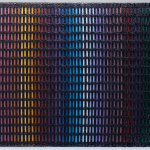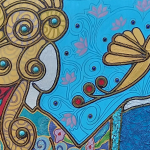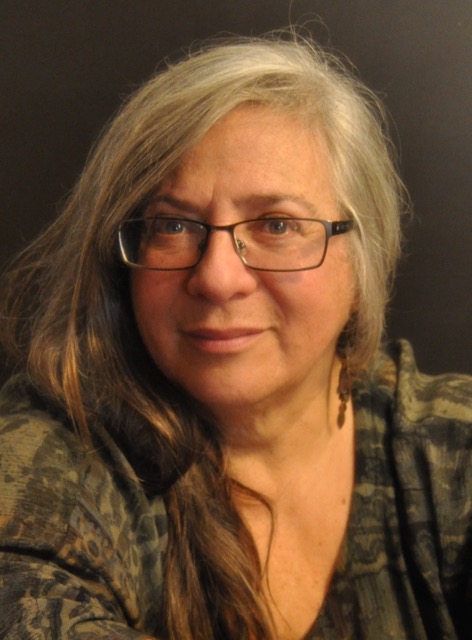
Dinamica, eclettica, dedita non solo alla manifestazione della sua creatività ma anche all’insegnamento e alla divulgazione dell’arte in tutte le sue forme al punto di essere divenuta un personaggio di spicco nel panorama artistico dell’Ontario, la sua regione di origine in Canada, Lise B.L. Goulet mostra fin da giovane un’attitudine creativa che accompagnerà tutta la sua esistenza conducendola a sperimentare varie forme espressive che si sono concretizzate e stabilizzate nel settore della ceramica artistica, quella attraverso la quale è in grado di dare forma e solidità alle proprie emozioni ma anche al messaggio che la sua sensibilità riceve dalla natura che la circonda. Si è laureata presso l’Università di Ottawa in Educazione e Arti Visive ma ben presto ha avvertito l’esigenza di approfondire la conoscenza e l’esecuzione delle acqueforti a cui sono seguiti i corsi con il maestro Makoto Yabé presso il Bennington College of Art in Vermont, USA dopo i quali ha sviluppato una serie di lavori basati su lastre Raku modellate in alto e basso rilievo; è stato quello il momento dal quale ha preso consapevolezza dell’amore verso la ceramica che è diventato il suo mezzo espressivo, quello attraverso cui esprime la sua personalità e il suo approccio aperto ed empatico nei confronti di quel mondo spesso ignorato che circonda l’uomo contemporaneo. Ma il suo percorso di apprendimento non è stato sufficiente a Lise B.L. Goulet per esprimere la sua complessa personalità che avvertiva il bisogno di dare vita a un consolidamento dell’importanza dell’apporto degli artisti nella società e anche nell’educazione scolastica, così ha intrapreso la carriera di insegnante di arti visive nelle scuole superiori di Orleans e Ottawa prima di dedicarsi al lavoro di gestione dell’educazione artistica a livello provinciale, in virtù del quale è stata responsabile della creazione del primo programma quadro di educazione artistica per le scuole superiori scritto interamente in francese. Ha creato il Programma Specializzato delle Arti, ora rinominato Accademia delle Arti, per il Conseil des écoles catholiques du Centre-est presso l’École secondaire catholique Béatrice-Desloges, insomma, una personalità intraprendente che le è valsa le cariche di Presidente e direttore esecutivo dell’Association francophone pour l’éducation artistique dell’Ontario a partire dal 2018 e quella di Responsabile dell’educazione artistica, dal 2004 al 2015, per le scuole di lingua francese dal primo al dodicesimo anno presso il Ministero dell’Istruzione di Toronto e, nel 19 novembre 2022, è stata nominata membro onorario di BRAVO-Bureau des regroupements des artistes visuels de l’Ontario-, per il suo lavoro di promozione e diffusione degli artisti visivi nell’Ontario francese, durante un evento di commemorazione del trentesimo anniversario di BRAVO, di cui è stata membro fondatore.. Eppure, nonostante i numerosi impegni dal punto di vista educativo e formativo, Lise B.L. Goulet ha un vasto percorso espositivo che l’ha condotta a essere citata nelle maggiori riviste del settore e ad avere collezionisti in Canada ma anche in altre parti del mondo.
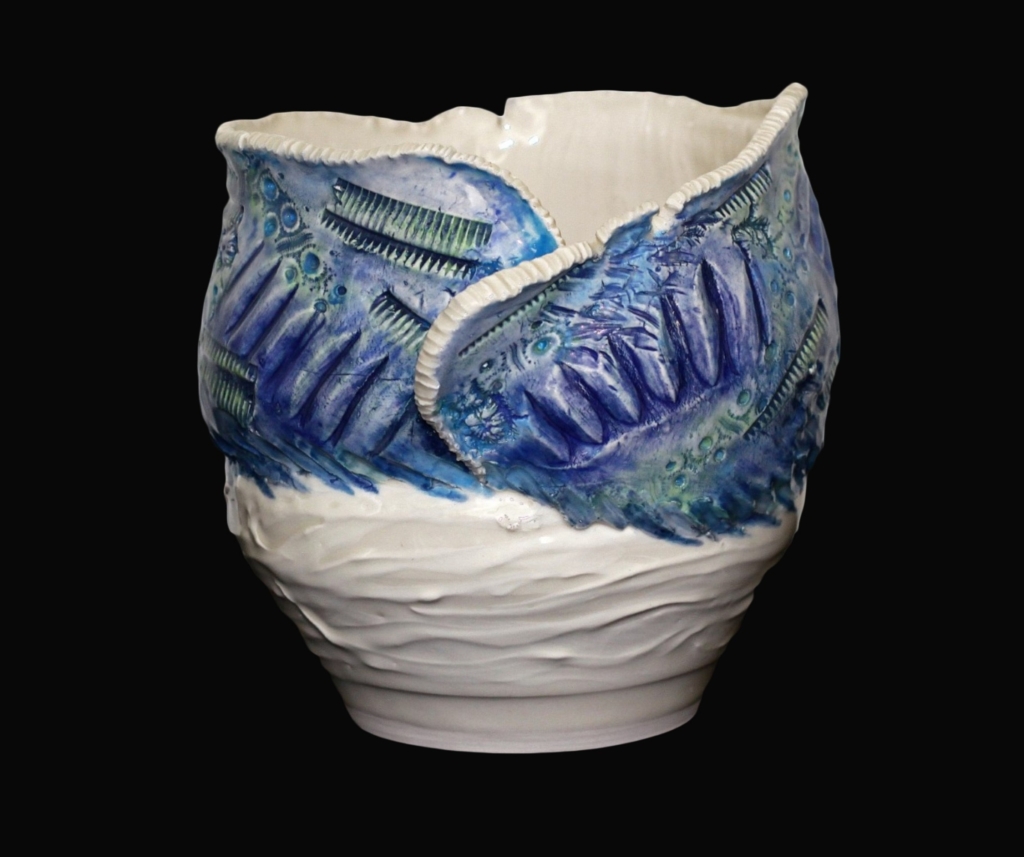
Le decorazioni delle sue ceramiche appartengono all’Espressionismo Astratto perché è attraverso questo stile che riesce a liberare le sue emozioni che si connettono con la natura, con l’acqua in special modo ma anche con la terra perché è in grado di ascoltare la voce silenziosa della natura che circonda, e di fatto nutre, la vita dell’essere umano, oltre che della flora e della fauna. La sua formazione incisoria emerge dai bordi che appaiono quasi intagliati, spesso aperti a sottolineare la trasformazione che l’oggetto inteso nel suo senso più tradizionale subisce modificandosi in altro, in una vera e propria opera d’arte sulla quale la Goulet può lasciare il suo messaggio, sensibilizzando l’osservatore nei confronti di quegli elementi naturali, come l’acqua, con i suoi fiumi e i mari, e la terra, intesa come testimone del passare del tempo e delle ere geologiche. La ceramica diviene pertanto scrigno prezioso, simbolo in cui l’artista racchiude quelle voci silenziose che contraddistinguono la storia stessa dell’umanità;
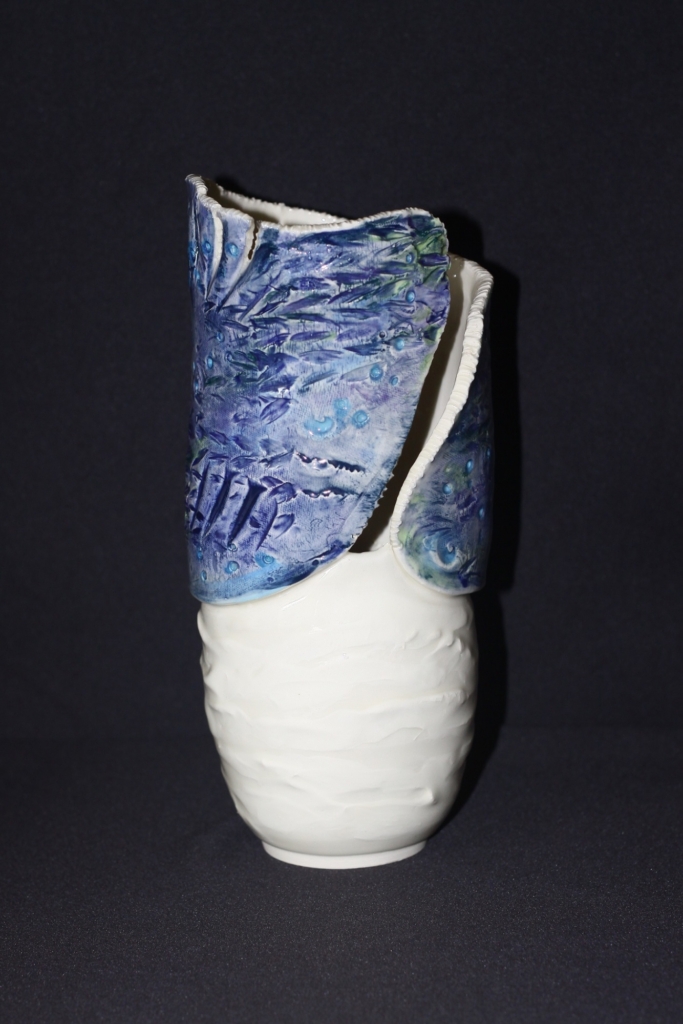
nell’ultima produzione si è dedicata a mettere in evidenza gli spartiacque, quei fenomeni idrografici che separano i differenti bacini acquiferi e che sono costantemente messi in pericolo a causa delle scelte inconsapevoli e scellerate dell’essere umano che troppo spesso dimentica di osservare e considerare maggiormente la natura nella sua forma e struttura originaria. Andiamo ora a scoprire di più di questa forte personalità artistica.
Lise, il suo cammino nel mondo dell’arte è iniziato fin da giovanissima; qual è stato il momento in cui ha compreso che la ceramica avrebbe costituito il mezzo espressivo più affine al suo intento creativo? Quanto peso ha avuto lo studio dell’arte incisoria nel suo successivo percorso con le ceramiche artistiche?
Il momento determinante è stato quando ho visitato i laboratori del Centre culturel La Ronde Inc. di Timmins. Mio zio materno Clément Bérini era il coordinatore delle attività di arti visive e ci mostrava i laboratori e in particolare quello di ceramica. Me ne sono innamorata quando avevo circa tredici anni. Nel corso degli anni ho sempre mantenuto i contatti con l’argilla. Ma è stato dopo gli studi universitari, tra gli altri, sulle tecniche di stampa e, successivamente l’insegnamento, dove facevo svolgere ai miei studenti attività didattiche con quella materia, che ho iniziato a sperimentare la ceramica, la lavorazione delle lastre e la stampa calcografica, sviluppando l’inizio del linguaggio estetico praticato oggi. Nel 1996 ho seguito un corso di formazione sulla tecnica di cottura RAKU con il maestro Makoto Yabé, che ha confermato l’orientamento estetico che avevo intrapreso. Diverse persone hanno mi hanno ispirato per questo questo percorso : Clément Bérini, Paul de Broeck, Jeanne Doucet, René Payant, Mary-Jean Clayton, Makoto Yabé, Rosemary Swan, a cui sono molto grata.
Non solo artista ma anche professoressa e creatrice di un metodo didattico per l’insegnamento dell’arte nella scuola secondaria. Cosa la appaga di più del suo ruolo di insegnante e cosa del suo essere artista? Pensa che il metodo possa determinare il talento oppure, al di là di quanto profonda sia la conoscenza teorica e pratica, il talento è quella marcia in più che funge da spartiacque tra un praticante e un artista?
Non credo molto nel talento. Credo che siano il desiderio, la passione, l’impegno a determinare la nostra presenza, piccola o grande che sia, nel mondo dell’arte. Quante volte ho visto nei miei studenti che era il gusto per l’arte, ciò che l’arte portava nella loro vita a determinare il loro successo nella pratica dell’arte. E quante volte ho visto il talento degli studenti ignorato perché non si credeva in esso o non lo si considerava un dono speciale che doveva essere coltivato e indirizzato delicatamente per sbocciare e illuminare la loro sensibilità. Quindi, la mia esperienza di insegnante e ciò che ho osservato mi costringe a credere fermamente che siano prima il desiderio, poi la passione e infine l’impegno, in quest’ordine, a creare un artista.
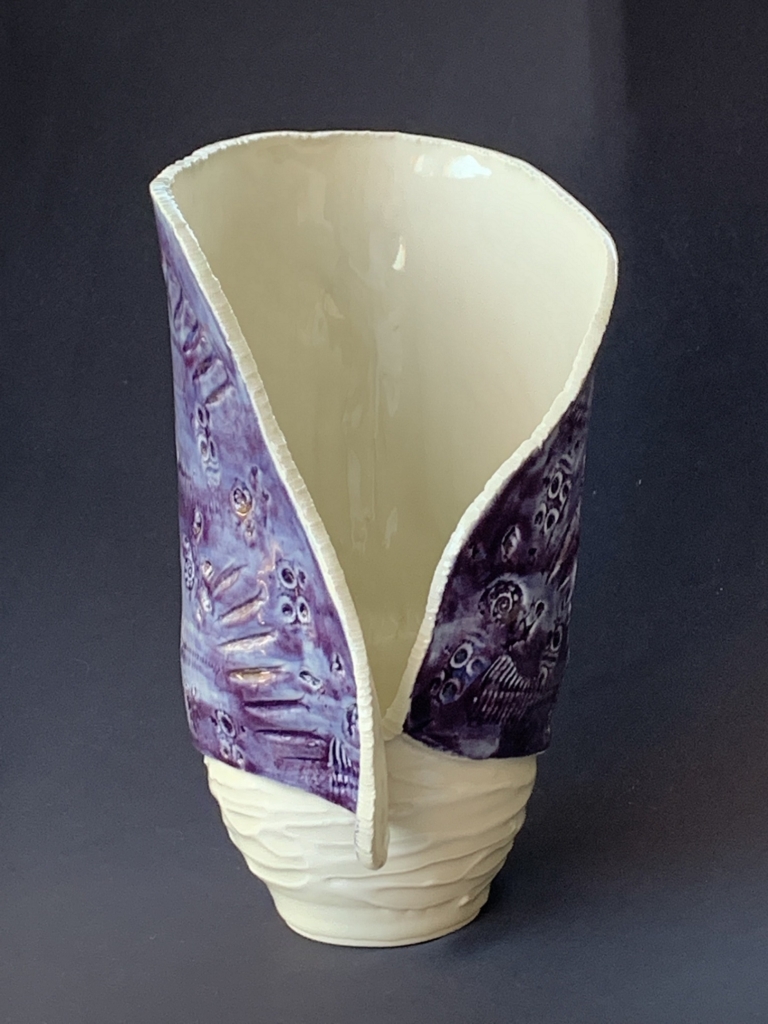
Ha anche avuto un incarico presso il Ministero dell’Istruzione di Toronto, ci vuole raccontare questa esperienza? Quanta attenzione c’è nei confronti dell’arte da parte delle istituzioni canadesi? E quanti fondi vengono riservati al settore artistico?
Lavorare al Ministero dell’Istruzione richiede capacità gestionali e organizzative, una conoscenza approfondita del settore amministrativo, educativo e artistico, la capacità di cogliere le opportunità che si presentano nel corso del lavoro quotidiano e, soprattutto, una visione di ciò che si sta gestendo affinché le proprie azioni di agente educativo diano frutti. Innanzitutto, è importante sapere che l’istruzione in Canada è responsabilità finanziaria e pedagogica di ogni provincia. Pertanto, la politica e la dichiarazione pedagogica del programma didattico per ogni disciplina a livello elementare e secondario dipende principalmente da chi viene scelto per gestirlo. Dunque la persona responsabile, il responsabile dell’istruzione, deve essere consapevole di tutto ciò che accade nell’ambiente politico e amministrativo, ma soprattutto della direzione e della visione che vuole dare al programma, ad esempio, nell’educazione artistica. Ciò richiede che l’insegnante di una classe abbia visto le innovazioni, sperimentato e testato nuove idee. Questo è il caso dell’educazione artistica, un programma di studi che comprende arti mediatiche, arti visive, danza, musica e teatro. Al centro della pratica artistica ci sono due processi: la creazione e l’analisi critica. In Ontario, l’educazione artistica ha la stessa importanza di tutte le altre materie del curriculum ed è un programma generale che viene seguito in tutte le materie in ogni grado della scuola elementare. A livello secondario, uno studente con un’esperienza di scuola elementare, scelta tra una delle materie, deve aver seguito un corso minimo di educazione artistica per ottenere il diploma di scuola secondaria. Gli studenti che hanno il gusto per l’arte scelgono una materia artistica e la perseguono in tutti i gradi della scuola secondaria, ossia nei gradi 9, 10, 11 e 12. Non so quanto denaro venga stanziato annualmente per l’educazione artistica, ma ogni consiglio scolastico, ce ne sono dodici di lingua francese in Ontario, è tenuto, in base alla legge sull’istruzione, a fornire fondi adeguati per la realizzazione di programmi di educazione artistica elementare e secondaria.
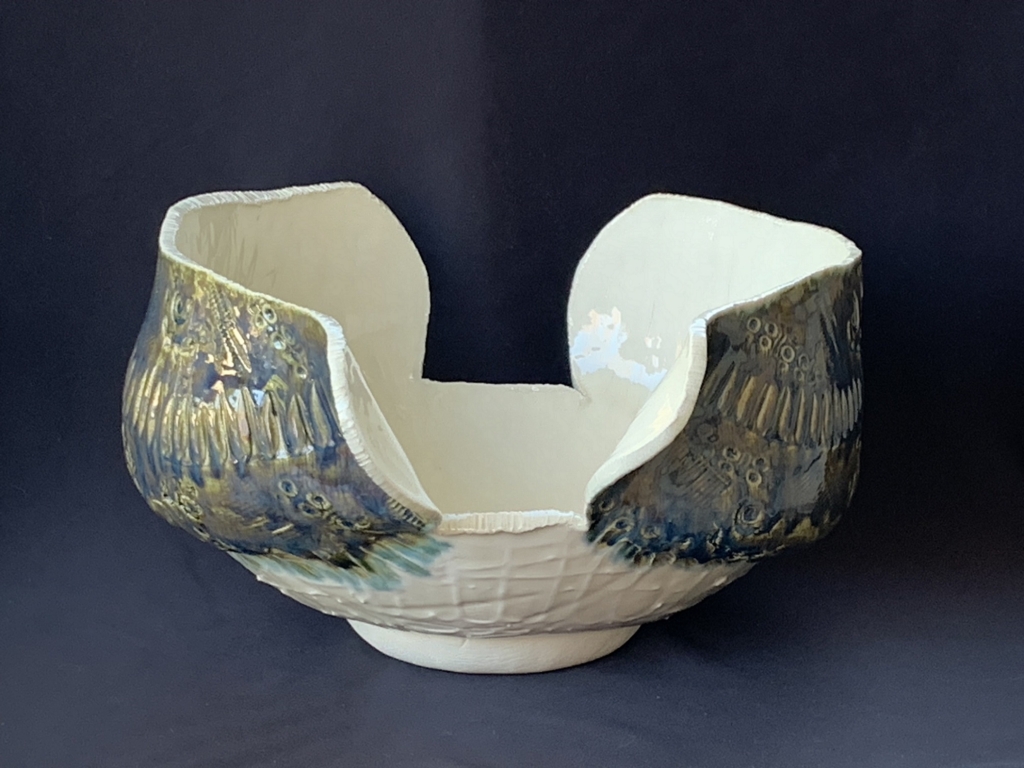
Il suo approccio espressivo è fortemente legato all’Espressionismo Astratto che funge da base per un’interpretazione della realtà ma soprattutto della naturalità, di un contatto con il mondo che ci accoglie, troppo spesso trascurato o violentato dall’uomo. Ci approfondisce questo concetto che è alla base della sua arte?
Che cos’è l’arte? Ecco alcune tracce di quello che, nel mio caso, è l’impulso a creare – ciò che mi incita, ciò che mi preoccupa, le domande che mi pongo – attraverso la pratica artistica. L’arte è l’immagine dell’ambiente in cui nasce, il suggerito, il palese, il segreto, è la sua incarnazione. Nel nostro secolo, l’arte si è gradualmente allontanata dalla rappresentazione letterale della realtà nel suo linguaggio poiché la fotografia ha sostituito il nostro bisogno di realismo. Jean-Paul Riopelle, un grande artista franco-canadese, una volta ha detto: l’arte non è cambiata dalla preistoria, quello che è successo è che vediamo in modo diverso (citazione libera!). Vediamo metaforicamente, percepiamo la realtà attraverso emozioni e sensazioni, comprendiamo attraverso suggestioni di forma e colore. Per questo motivo lavoro al limite del non figurativo, quello che la storia dell’arte ha chiamato Espressionismo Astratto. Lo spettatore porta nell’opera la propria esperienza, questo è il messaggio trasmesso, da cui la ricchezza dell’opera, che si adatta allo spettatore e a volte lo tocca nel profondo. L’intenzione artistica può essere simile o meno al messaggio trasmesso, è lo scopo dell’artista. L’attività creativa è per me per l’altro. Che cos’è l’arte? L’arte è espressione personale. Direi addirittura che è la capacità di muoversi, di toccare gli altri e se stessi nella speranza di cambiare il mondo attraverso la consapevolezza che suscita e le azioni che ci incoraggiano a vedere ed essere in modo diverso.
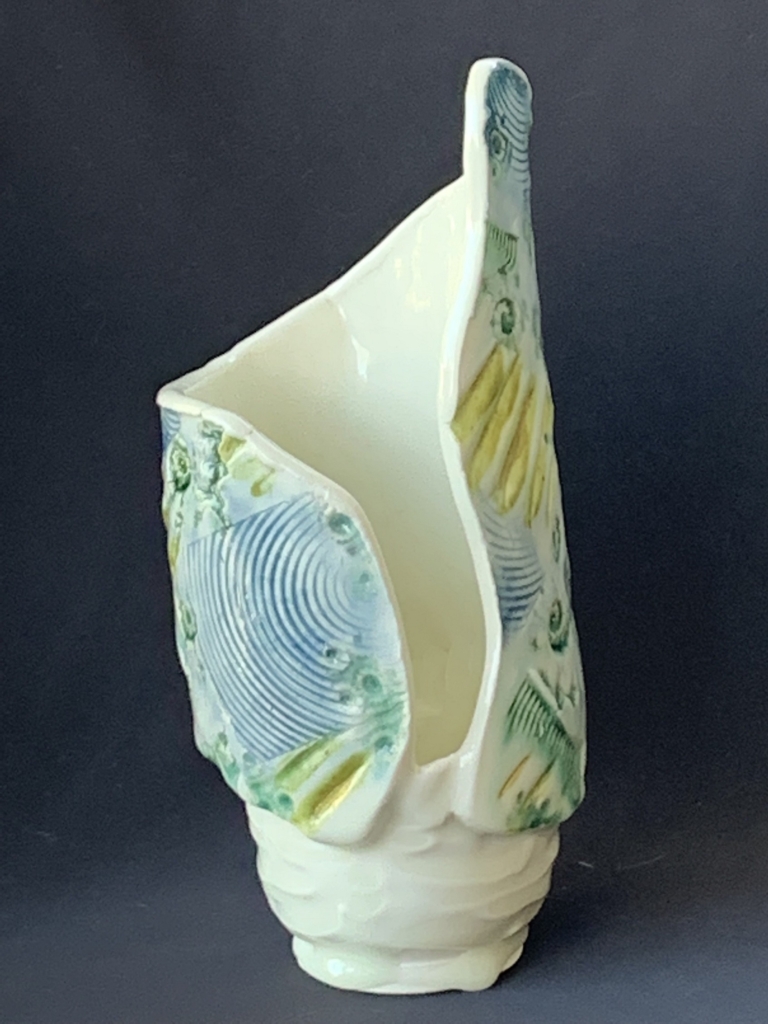
Lei ha cominciato a esporre negli anni Novanta del Ventesimo secolo, e non si è più fermata; ha all’attivo molteplici mostre personali e collettive, è membro di molte associazioni culturali, ha avuto incarichi pubblici e le sue opere sono state pubblicate in importanti cataloghi e libri d’arte. Ci racconta quali sono i suoi prossimi progetti?
Nel prossimo futuro, voglio continuare il mio lavoro creativo verso ciò che la natura non smette mai di trasmetterci: la luce. In senso lato è l’illuminazione, in senso stretto è la considerazione dell’ecosistema, l’eterna permutazione del ciclo dell’H2O. In secondo luogo, è esporre lo spettatore al più grande (macrocosmo) e al più piccolo (microcosmo) per fargli capire il potere della sua impronta, nel bene e nel male. Vorrei che il mio lavoro fosse conseguente alla nostra coscienza e che incoraggiasse le azioni che intraprendiamo non solo per la sopravvivenza della “Madre Terra-Mare”, ma per la sua capacità di rinnovarsi. Soprattutto, voglio continuare a scoprire questo “Mare Madre di nascita e rigenerazione” che è la pratica artistica. Dal punto di vista espositivo ho in programma molti progetti ma uno in particolare mi entusiasma molto perché nell’agosto del 2023 avrò una mostra a Firenze dove potrò proporre per la prima volta al pubblico italiano i miei lavori.
LISE B. L. GOULET-CONTATTI
Email: marcelleclement1@gmail.com
Sito web: http://www.bravoart.org/cb-profile/380-goulet
Facebook: https://www.facebook.com/lisebl.goulet.5
Marta Lock’s interviews: Lise B.L. Goulet, a deep sensitivity to all the elements of nature that manifests itself in her artistic ceramics
Dynamic, eclectic, dedicated not only to the manifestation of her creativity but also to teaching and disseminating art in all its forms to the point that she has become a leading figure in the artistic scene in Ontario, her home region in Canada, Lise B.L. Goulet showed a creative aptitude from a young age that would accompany her entire existence, leading her to experiment with various forms of expression that took shape and stabilised in the field of artistic ceramics, through which she is able to give form and solidity to her emotions but also to the message that her sensitivity receives from the nature that surrounds her. She graduated from the University of Ottawa in Education and Visual Arts but soon felt the need to deepen her knowledge and execution of etchings. This was followed by courses with master Makoto Yabé at the Bennington College of Art in Vermont, USA after which she developed a series of works based on Raku plates modelled in high and low relief; that was the moment from which she became aware of her love for ceramics that has become her medium of expression, the one through which she expresses her personality and her open and empathetic approach to the often ignored world that surrounds contemporary man. But her path of learning was not enough for Lise B.L. Goulet to express her complex personality that felt the need to give life to a consolidation of the importance of the contribution of artists in society and also in school education, so she embarked on a career as a visual arts teacher in high schools in Orleans and Ottawa before dedicating herself to the work of managing arts education at the provincial level, under which she was responsible for the creation of the first high school art education framework programme written entirely in French. She created the Specialised Arts Programme, now renamed the Academy of Arts, for the Conseil des écoles catholiques du Centre-est at the École secondaire catholique Béatrice-Desloges, an enterprising personality that has earned her the positions of President and Executive Director of the Association francophone pour l’éducation artistique of Ontario as of 2018 and that of Head of Arts Education, from 2004 to 2015, for French-speaking schools from Year 1 to Year 12 at the Ministry of Education in Toronto and, on November19 2022, she has been named an honorary member of BRAVO-Bureau des regroupements des artistes visuels de l’Ontario-, for her work in promoting and disseminating visual artists in French Ontario, during an event commemorating the 30th anniversary of BRAVO, of which she was a founding member. Yet, despite her many commitments from an educational and training point of view, Lise B.L. Goulet has a wide exhibition career that has led her to be mentioned in major magazines and to have collectors in Canada but also in other parts of the world. The decorations of her ceramics belong to Abstract Expressionism because it is through this style that she is able to release her emotions that connect with nature, with water in particular, but also with the earth because she is able to listen to the silent voice of nature that surrounds, and in fact nourishes, the life of human beings, as well as flora and fauna. Her engraving formation emerges from the edges that appear almost carved, often open to emphasise the transformation that the object intended in its most traditional sense undergoes, changing into something else, into a true work of art on which Goulet can leave her message, sensitising the observer to the natural elements, such as water, with its rivers and seas, and the earth, as a witness to the passage of time and geological eras. Ceramics therefore become a precious casket, a symbol in which the artist encloses those silent voices that distinguish the very history of mankind. In her latest production, she has dedicated herself to highlighting watersheds, those hydrographic phenomena that separate the different aquifers and that are constantly endangered due to the unconscious and wicked choices of human beings who too often forget to observe and consider nature in its original form and structure. Let us now discover more about this strong artistic personality.
Lise, your path in the world of art began at a very young age; what was the moment when you realised that ceramics would be the expressive medium most akin to your creative intentions? How much influence did the study of the art of engraving have on your subsequent path with artistic ceramics?
The defining moment was when I visited the workshops of Centre culturel La Ronde Inc. in Timmins. My maternal uncle Clément Bérini was the coordinator of the visual arts activities and he showed us the workshops, particularly the ceramics workshop. I fell in love with it when I was about thirteen years old. Over the years, I always kept in touch with clay. But it was after my university studies, among others, on printing techniques and, later, teaching, where I had my students carry out didactic activities with that subject, that I started experimenting with ceramics, plate making and intaglio printing, developing the beginnings of the aesthetic language practised today. In 1996, I attended a training course on the RAKU firing technique with master Makoto Yabé, which confirmed the aesthetic orientation I had taken. Several people have inspired me along this path: Clément Bérini, Paul de Broeck, Jeanne Doucet, René Payant, Mary-Jean Clayton, Makoto Yabé, Rosemary Swan, to whom I am very grateful.
Not only an artist but also a teacher and creator of a didactic method for teaching art in secondary schools. What appeals to you most about your role as a teacher and what about your being an artist? Do you think that the method can determine talent or, apart from how deep the theoretical and practical knowledge is, talent is that extra gear that acts as a watershed between a practitioner and an artist?
I don’t believe much in talent. I believe that it is the desire, the passion, the commitment that determines our presence, however small or large, in the art world. How many times I have seen in my students that it was the taste for art, what art brought to their lives that determined their success in the practice of art. And how often I have seen students’ talent ignored because they did not believe in it or did not consider it a special gift that needed to be nurtured and gently directed to blossom and illuminate their sensibilities. So, my own teaching experience and what I have observed, forces me to firmly believe that it is first desire, then passion and then commitment, in that order, that wins over the artist.
You also had an assignment with the Ministry of Education in Toronto, would you like to tell us about this experience? How much attention is there towards art on the part of Canadian institutions? And how much funding is reserved for the arts sector?
Working at the Ministry of Education requires management and organisational skills, a thorough knowledge of the administrative, educational and artistic sectors, the ability to seize opportunities that arise in the course of daily work, and, above all, a vision of what you are managing so that your actions as an educational agent bear fruit. First of all, it is important to know that education in Canada is the financial and pedagogical responsibility of each province. Therefore, the policy and pedagogical statement of the curriculum for each discipline at elementary and secondary level depends primarily on who is chosen to manage it. Therefore, the person in charge of education, must be aware of everything that goes on in the political and administrative environment, but especially of the direction and vision he wants to give the programme, for example, in art education. This requires that the teacher of a class has seen innovations, experienced and tested new ideas. This is the case in arts education, a curriculum that includes media arts, visual arts, dance, music and theatre. At the core of arts practice are two processes: creation and critical analysis. In Ontario, arts education has the same importance as all other subjects in the curriculum and is a general programme that is followed in all subjects in every grade of primary school. At the secondary level, a student with a primary school experience, chosen from one of the subjects, must have taken a minimum course in art education to obtain a secondary school diploma. Students who have a taste for the arts choose an arts subject and pursue it in all secondary school grades, i.e. grades 9, 10, 11 and 12. I do not know how much money is allocated annually for arts education, but each school board, there are twelve French-speaking boards in Ontario, is required by the Education Act to provide adequate funds for elementary and secondary arts education programmes.
Your expressive approach is strongly linked to Abstract Expressionism, which serves as the basis for an interpretation of reality but above all of naturalness, of a contact with the world that welcomes us, which is too often neglected or raped by man. Would you elaborate on this concept that forms the basis of your art?
What is art? Here are some traces of what, in my case, is the impulse to create – what incites me, what concerns me, the questions I ask myself – through artistic practice. Art is the image of the environment in which it is born, the suggested, the overt, the secret, it is its embodiment. In our century, art has gradually moved away from the literal representation of reality in its language as photography has replaced our need for realism. Jean-Paul Riopelle, a great French-Canadian artist, once said: art has not changed since prehistory, what has happened is that we see differently (free quote!). We see metaphorically, we perceive reality through emotions and sensations, we understand through suggestions of form and colour. This is why I work on the border of the non-figurative, what art history has called Abstract Expressionism. The viewer brings his own experience into the work, this is the message conveyed, hence the richness of the artwork, which adapts to the viewer and sometimes touches him deeply. The artistic intention may or may not be similar to the message conveyed, it is the artist’s purpose. Creative activity is for me for the other. What is art? Art is personal expression. I would even say it is the ability to move, to touch others and oneself in the hope of changing the world through the awareness it raises and the actions that encourage us to see and be differently.
You started exhibiting in the 1990s and have not stopped since; you have numerous solo and group exhibitions to your credit, you are a member of many cultural associations, you have had public commissions and your works have been published in important catalogues and art books. Can you tell us what are your next projects?
In the near future, I want to continue my creative work towards what nature never ceases to transmit to us: light. In a broad sense it is illumination, in a narrow sense it is the consideration of the ecosystem, the eternal permutation of the H2O cycle. Secondly, it is exposing the viewer to the larger (macrocosm) and the smaller (microcosm) to make them understand the power of their imprint, for better or worse. I want my work to be consequential to our consciousness and to encourage the actions we take not only for the survival of ‘Mother Earth-Sea’, but for her ability to renew herself. Above all, I want to continue to discover this ‘Mother Sea of birth and regeneration’ that is art practice. From an exhibition point of view, I have many projects planned, but one in particular excites me a lot because in August 2023 I will have an exhibition in Florence where I will be able to present my work to the Italian public for the first time.

